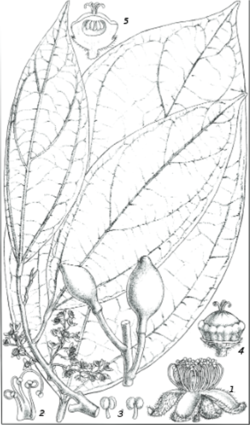| Peridiscus | |
|---|---|
 | |
| Peridiscus lucidus | |
| Scientific classification | |
| Kingdom: | Plantae |
| Clade: | Tracheophytes |
| Clade: | Angiosperms |
| Clade: | Eudicots |
| Order: | Saxifragales |
| Family: | Peridiscaceae |
| Genus: | Peridiscus Benth. |
| Species: | P. lucidus |
| Binomial name | |
| Peridiscus lucidus Benth. | |
Peridiscus lucidus is a species of flowering plant, the only species in the genus Peridiscus, which is one of four genera within the family Peridiscaceae. [1] It grows in Venezuela and northern Brazil, in evergreen, sometimes riverine forests. [2] It was originally described by Bentham and Hooker in 1862. [3] The taxonomic history of Peridiscus and of Peridiscaceae is complex, and has been resolved by molecular phylogenetic analysis.